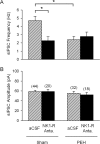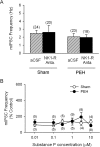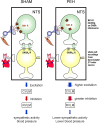Exercise reduces GABA synaptic input onto nucleus tractus solitarii baroreceptor second-order neurons via NK1 receptor internalization in spontaneously hypertensive rats
- PMID: 19261870
- PMCID: PMC2682348
- DOI: 10.1523/JNEUROSCI.4413-08.2009
Exercise reduces GABA synaptic input onto nucleus tractus solitarii baroreceptor second-order neurons via NK1 receptor internalization in spontaneously hypertensive rats
Abstract
A single bout of mild to moderate exercise can lead to a postexercise decrease in blood pressure in hypertensive subjects, namely postexercise hypotension (PEH). The full expression of PEH requires a functioning baroreflex, hypertension, and activation of muscle afferents (exercise), suggesting that interactions in the neural networks regulating exercise and blood pressure result in this fall in blood pressure. The nucleus tractus solitarii (NTS) is the first brain site that receives inputs from nerves carrying blood pressure and muscle activity information, making it an ideal site for integrating cardiovascular responses to exercise. During exercise, muscle afferents excite NTS GABA neurons via substance P and microinjection of a substance P-neurokinin 1 receptor (NK1-R) antagonist into the NTS attenuates PEH. The data suggest that an interaction between the substance P NK1-R and GABAergic transmission in the NTS may contribute to PEH. We performed voltage clamping on NTS baroreceptor second-order neurons in spontaneously hypertensive rats (SHRs). All animals were killed within 30 min and the patch-clamp recordings were performed 2-8 h after the sham/exercise protocol. The data showed that a single bout of exercise reduces (1) the frequency but not the amplitude of GABA spontaneous IPSCs (sIPSCs), (2) endogenous substance P influence on sIPSC frequency, and (3) sIPSC frequency response to exogenous application of substance P. Furthermore, immunofluorescence labeling in NTS show an increased substance P NK1-R internalization on GABA neurons. The data suggest that exercise-induced NK1-R internalization results in a reduced intrinsic inhibitory input to the neurons in the baroreflex pathway.
Figures








References
-
- Bonham AC, Chen CY. Glutamatergic neural transmission in the nucleus tractus solitarius: N-methyl-d-aspartate receptors. Clin Exp Pharmacol Physiol. 2002;29:497–502. - PubMed
-
- Boone JB, Jr, Corry JM. Proenkephalin gene expression in the brainstem regulates post-exercise hypotension. Brain Res Mol Brain Res. 1996;42:31–38. - PubMed
-
- Boscan P, Paton JF. Excitatory convergence of periaqueductal gray and somatic afferents in the solitary tract nucleus: role for neurokinin 1 receptors. Am J Physiol Regul Integr Comp Physiol. 2005;288:R262–R269. - PubMed
-
- Catelli JM, Sved AF. Enhanced pressor response to GABA in the nucleus tractus solitarii of the spontaneously hypertensive rat. Eur J Pharmacol. 1988;151:243–248. - PubMed
-
- Chandler MP, DiCarlo SE. Sinoaortic denervation prevents postexercise reductions in arterial pressure and cardiac sympathetic tonus. Am J Physiol. 1997;273:H2738–H2745. - PubMed
Publication types
MeSH terms
Substances
Grants and funding
LinkOut - more resources
Full Text Sources
Other Literature Sources
Molecular Biology Databases
